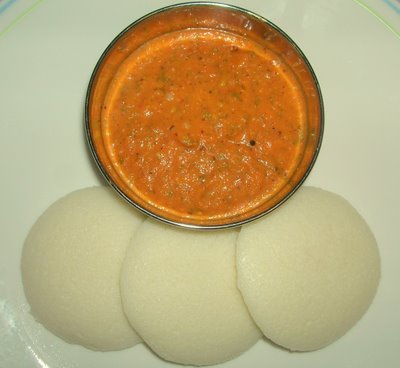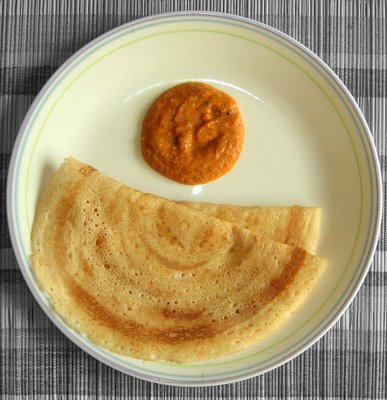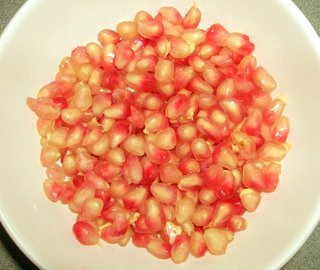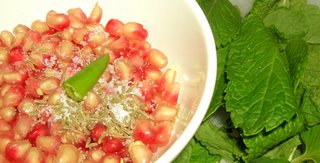Popular Posts
May 24, 2011
Coconut chutney for Iddli and dosa varieties
Jul 16, 2010
Sprouted Methi pickle / Menthya thokku / Vendhaya thokku
Spicy, tangy, bitter and yet sweet = 'sprouted methi thokku', an authentic family recipe that my mother in law and her mom and her elder sister shared with me. They have taught me many many authentic recipes and this is one among them. Thank you avva, dodamma and amma. Thank you for passing on the tradition to us. Will keep posting many more family recipes.
Fenugreek - Health benefits : The fenugreek seeds are primarily used as a culinary spice across many cultures, while herbalists had used them for many centuries for the many health benefits it offers. The fenugreek seeds or fenugreek extract possess a powerful ability in aiding the digestive process, which is one of the many benefits of fenugreek (more here)
Sprouting methi seeds: Sprouting the methi seeds is simple. Take half a cup of dry methi/fenugreek seeds. Wash well and soak in water for at least 24 to 36 hours. Drain water completely and transfer the content to a colander. Cover with wet cloth. I used a wet kitchen towel. Keep it aside undisturbed. Make sure you keep the cover moist at all times. Within a day or two, you will notice small sprouts shooting out. I left it for two days until the sprouts were 1 cm long.
Dry methi seeds- half cup or Sprouted methi seeds- 2 cups
Also, this recipe is my entry to 'Let's sprout'- a new event in Priya's easy and tasty recipes.
Jun 25, 2010
Sorakkai thogayal / Bottle gourd chutney
Jun 16, 2010
Chayote chutney / Chow chow thogayal
Feb 23, 2009
Kadle bele or Gram dal chutney for rice
 I used kadle bele (otherwise called gram dal or chana dal) to make a quick and tasty chutney. Rice with this chutney and some javarisi vadam is heaven. I sometimes side this rice with curd if the chutney is too spicy.
I used kadle bele (otherwise called gram dal or chana dal) to make a quick and tasty chutney. Rice with this chutney and some javarisi vadam is heaven. I sometimes side this rice with curd if the chutney is too spicy. Aug 15, 2008
Grilled mango chutney

Dec 28, 2007
Ridge gourd peppercorn chutney / heerekai menusu chutney

Ridge gourd / Heerekai - long - 6
May 10, 2007
Tomato / Thakkali Thokku



Apr 30, 2007
Curry Leaves Kudhi Menusu


I found a wonderful article about curry leaves, in buzzle.com, written by Kanika Goswami. She says, Apart from cooking, the curry leaf has a number of medicinal uses also. It is an essential ingredient of almost all traditional medicine systems of peninsular India, sometimes with amazingly good results. Unani, Ayurveda and other systems use it to cure ailments such as piles, to allay heat of the body and are useful in leucoderma and blood disorders, and this has been proven by experts of western medicine also. In India, the curry leaf is used to prevent conditions such as nausea and stomach upsets. It is also used in treating skin irritations and poisonous bites. Its oils are invaluable as repellants and to cure skin disorders common to the tropics. More...
Also, Here's a post about the Curry leaves by Prabudesai in Benifits of Indian food.

Curry Leaves - 2 to 3 Cups

Method:
Wash Curry Leaves and Drain Water. Toss in a heated Pan for a couple of minutes. When its almost room temperature, grind the leaves with Ginger, Tamarind and Peppercorns using water little by little. Do not use more water.
Heat Oil in a Kadai and tamper the Mustard Seeds. Add the Asafoetida powder and then add the ground paste. Add Salt and Fry until all the moisture is absorbed.
Serve a teaspoon of this with a cup of hot steaming rice and a spoon of ghee. Mix well and enjoy the delight.

Feb 13, 2007
Tomato Coriander Leaves Chutney

No water required while frying or while grinding. The juice from tomato is enough.
Dec 5, 2006
Heerekai Chutney / Ridge Gourd Chutney

2 Long Ridge Gourds – The skin should not be shrunk too much between the ridges.
2 Green Chillis slit three forth vertically
Asafoetida
Salt
Tamarind Concentrate – very little, may be less than ¼ of a small spoon
Curry Leaves – 1 stalk
Method:
Peel off the Ridge Gourd Skin and Cut both the ends. Taste for Bitterness. Do not use Bitter Ridge Gourds. Dice the Ridge Gourd.
Heat the Diced Gourd along with the Green Chillis in low Heat. Do not add water. The Gourd itself will let out some Water. Stir occasionally and Cook for a while until all the water is evaporated. Let it cool down.
Take out only one Green Chilli and Grind the Cooked Gourd (with one green chilli) along with Asafoetida, Salt, Tamarind Concentrate and Curry leaves. Grind to a smooth Paste. Season if you want to. Serve this Chutney with Steaming Rice.
Dec 4, 2006
Rajma Chutney / Red Kidney Beans Chutney

Ingredients:
Rajma (Red Kidney Beans) – ¾ cup Soaked overnight
Ripe Juicy Tomatoes – 4 – Chop the tomatoes finely
Mustard Seeds – 1 teaspoon
Urud Dal – 1 teaspoon
Cumin Seeds – 1 teaspoon
Grated Ginger – ½ teaspoon (optional)
Oil – 1 tablespoon
Asafoetida
Salt
Red Chilli Powder
Turmeric Powder
Dhania Powder – 1 teaspoon
Coriander Leaves – 1 tablespoon – finely chopped
Method:
Cook Rajma in Pressure cooker and keep it aside.
Heat Oil in a Pressure Pan or Kadai, Add Mustard Seeds, when it sputters, add the Urud Dal and Cumin Seeds, then add the chopped Tomatoes and fry until the tomatoes are cooked. While it is boiling, add Asafoetida, Red Chilli Powder, Turmeric Powder, Dhania and Salt. Add little water if needed. The consistency should not be too thick or too loose. Let it cool down.
Mix in the chopped Coriander leaves.
This chutney can be served as a side for Chapathis or can be Mixed with Rice. This can also be used as a Spread for Toasted Bread for a high Protein Breakfast.
Nov 22, 2006
Tomato Mint Chutney


Ripe Tomatoes – 5
A small bunch of Mint leaves
Cumin – 1 ½ teaspoon
Mustard Seeds – ½ teaspoon
Urud Dal – 1 tablespoon
Turmeric Powder
Red Chilli Powder
Asafoetida
Salt
Oil – 1 tablespoon
Method:
Chop Tomatoes finely.
Heat oil in a Kadai and add mustard seeds, when it sputters, add Cumin and Urud Dal. Then add the chopped Tomatoes. Fry until the Tomatoes are cooked. When it is boiling, add Turmeric Powder, Asafoetida, Red Chilli Powder and Salt. Fry for sometime and let the spices blend well with the Tomatoes. Now, add the Mint leaves and fry for a couple of minutes. Turn off the heat completely. Let the content Cool. Grind it to a smooth paste. Do not add water. Tasty Chutney is ready for Dosa or Idli.
Nov 6, 2006
Pomegranate Mint Chutney
I had a small bunch of Mint and a ripe Pomegranate in my pantry. A wild idea struck me. Why not combine the two to make a Chutney that I have never tasted before. A Chutney for the Dosa that I was planning for the night. The idea worked and the result was a delicious sweetie, minty chutney. My husband and my little daughter loved it. Try this recipe. (The yield for the recipe below is very little. You can increase the Measurements Proportionately, if you want more chutney.)
Ingredients:
1 large ripe Pomegranate.
1 Small bunch of Mint
½ Green Chilli (if it’s too hot)
1 teaspoon Cummin (Jeera)
Salt to taste
Method:
Grind the Pomegranate Seeds with Cummin Seeds, Green Chilli and Salt, to a smooth paste. Do not add water as the fruit has enough juice to grind. (The Paste will be a little Coarse due to the seeds and that’s okay.) Now add the mint and grind again until the mint is ground to a paste. Chutney is ready in Seconds. No seasoning required. It’s a low Calorie and no Oil recipe for Dosa or Chapathi.











